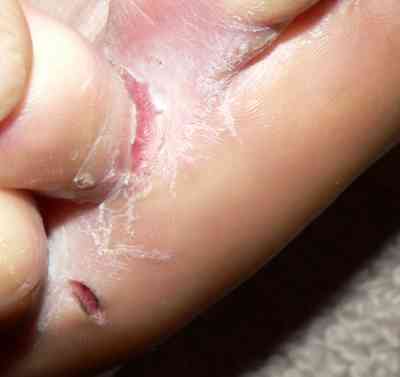Trichophyton rubrum
| Trichophyton rubrum | ||||||||||||||
|---|---|---|---|---|---|---|---|---|---|---|---|---|---|---|
 T. rubrum infection of a foot
| ||||||||||||||
| Scientific classification | ||||||||||||||
| ||||||||||||||
| Binomial name | ||||||||||||||
| Trichophyton rubrum |
Editor-In-Chief: C. Michael Gibson, M.S., M.D. [1]
Overview
Trichophyton rubrum is a fungus that is the most common cause of athlete's foot , jock itch and ringworm. This fungus was first desribed by Malmsten in 1845.[1] The growth rate of Trichophyton colonies is slow to moderately rapid. The texture is waxy, glabrous to cottony. From the front, the color is white to bright yellowish beige or red violet. Reverse is pale, yellowish, brown, or reddish-brown. Although the tricophyton rubum is the most common of the dermatophytes causing fingernail fungus infections, there are others. Tricophytum mentagrophytes is the second most common source of fungal nail infections from the dermatophyte group.
Common Skin Diseases
- Ringworm properly known as dermatophytosis
- Athlete's foot properly known as Tinea pedis
- Jock itch properly known as Tinea cruris
- Fungal Folliculitis of the Scalp properly known as Tinea capitis
- Fungal Folliculitis of the Beard properly known as Tinea barbae
- Fungal Folliculitis of the Legs properly known as Majocchi granuloma often occurs in females who shave their legs.
- Onychomycosis
Identification
Positive, selective diagnosis of T. rubrum is difficult as many members of the genus react similarly with test reagents. The Mycology Unit at the Adelaide Women's and Children's Hospital uses a dermatophyte identification scheme, devised by the late Gerraldine Kaminski, comprising 6 different media to help identify and differentiate the various species and strains of Trichophyton. The media in this scheme are Littman Oxgall agar, Lactritmel agar, Sabouraud's agar with 5% NaCl, 1% Peptone agar, Trichophyton agar No. 1, and hydrolysis of urea.
References
- ↑ William Williams, The Principles and Practice of Veterinary Surgery, p.734, W.R. Jenkins, 1894, from the collection of the University of California.